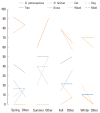Seasonal variation in skin sensitivity to aeroallergens
- PMID: 24003387
- PMCID: PMC3756177
- DOI: 10.4168/aair.2013.5.5.301
Seasonal variation in skin sensitivity to aeroallergens
Abstract
Purpose: We previously demonstrated seasonal variation in sensitization to aeroallergens in a small group of patients with exercise-induced asthma. This study was performed to confirm the relationship in a much larger population.
Methods: The charts of 1,891 patients who received allergy skin prick tests were reviewed retrospectively. The test results from subjects aged ≤60 years were compared between the groups classified according to the season when the patients received the tests (spring: March-May, summer: June-August, fall: September-November, winter: December-February). The data from 25 respiratory allergy patients who received the tests two or more times and showed a positive response at least once were analyzed longitudinally.
Results: The most prevalent among 29 tested aeroallergens were house dust mites (HDMs) Dermatophagoides pteronyssinus and D. farinae. The skin sensitization rates to D. pteronyssinus (23.2% vs. 32.1%, P=0.004) and D. farinae (22.2% vs. 30.2%, P=0.009) were significantly lower in the summer and higher in the fall (38.3% vs. 26.6% and 35.6% vs. 25.3%; P=0.001 respectively) than those in other seasons in patients with a respiratory allergy (n=1,102). The sensitization rates to weed pollens in the fall (13.9% vs. 8.3%, P=0.006) and to Aspergillus fumigatus in the winter (2.9% vs. 0.7%, P=0.005) were significantly higher. In patients with non-respiratory allergy such as urticaria/anaphylaxis (n=340), the D. farinae sensitization rate was significantly lower in the summer also but higher in the spring. The trend of the HDM sensitization rate being lower in the summer and higher in the fall was observed in the longitudinal study.
Conclusions: Skin sensitivity to aeroallergens such as HDMs, pollens, and molds demonstrates seasonal variation in respiratory allergy patients. Non-respiratory allergy patients also showed seasonal variation in sensitivity to aeroallergens, which might be related to the "priming" effect of allergens.
Keywords: Seasonal variation; aeroallergens; allergy; skin sensitivity.
Conflict of interest statement
There are no financial or other issues that might lead to conflict of interest.
Figures


Similar articles
-
Contact and aeroallergens in adulthood atopic dermatitis.J Eur Acad Dermatol Venereol. 2008 Nov;22(11):1346-55. doi: 10.1111/j.1468-3083.2008.02886.x. Epub 2008 Aug 1. J Eur Acad Dermatol Venereol. 2008. PMID: 18680530
-
Prevalence of sensitization to aeroallergens in California patients with respiratory allergy. Allergy Skin Test Project Team.Ann Allergy Asthma Immunol. 1998 Sep;81(3):203-10. doi: 10.1016/s1081-1206(10)62813-x. Ann Allergy Asthma Immunol. 1998. PMID: 9759795
-
The Differences in Serum Quantitative Specific IgE Levels Induced by Dermatophagoides pteronyssinus, Dermatophagoides farinae and Blomia tropicalis Sensitization in Intermittent and Persistent Allergic Asthma.Acta Med Indones. 2017 Oct;49(4):299-306. Acta Med Indones. 2017. PMID: 29348379
-
Seasonal factors influencing exercise-induced asthma.Allergy Asthma Immunol Res. 2012 Jul;4(4):192-8. doi: 10.4168/aair.2012.4.4.192. Epub 2012 Feb 24. Allergy Asthma Immunol Res. 2012. PMID: 22754712 Free PMC article.
-
Prevalence of skin reactions to aeroallergens in asthmatics of Puerto Rico.P R Health Sci J. 1997 Dec;16(4):359-67. P R Health Sci J. 1997. PMID: 9580406
Cited by
-
Impact of Allergic Reactions on Food-Specific IgE Concentrations and Skin Test Results.J Allergy Clin Immunol Pract. 2016 Mar-Apr;4(2):239-45.e4. doi: 10.1016/j.jaip.2015.11.015. Epub 2015 Dec 21. J Allergy Clin Immunol Pract. 2016. PMID: 26718150 Free PMC article.
-
Usefulness of House Dust Mite Nasal Provocation Test in Asthma.Allergy Asthma Immunol Res. 2017 Mar;9(2):152-157. doi: 10.4168/aair.2017.9.2.152. Allergy Asthma Immunol Res. 2017. PMID: 28102060 Free PMC article.
-
Sensitization to inhaled and food allergen sources in patients with allergic diseases in Eastern China.Front Allergy. 2025 Aug 20;6:1616730. doi: 10.3389/falgy.2025.1616730. eCollection 2025. Front Allergy. 2025. PMID: 40909166 Free PMC article.
-
Report of Common Aeroallergens among Allergic Patients in Northeastern Iran.Iran J Otorhinolaryngol. 2017 Mar;29(91):89-94. Iran J Otorhinolaryngol. 2017. PMID: 28393056 Free PMC article.
-
House dust mite and Cockroach specific Immunoglobulin E sensitization is associated with diabetes mellitus in the adult Korean population.Sci Rep. 2018 Feb 8;8(1):2614. doi: 10.1038/s41598-018-20573-0. Sci Rep. 2018. PMID: 29422615 Free PMC article.
References
-
- Abbas AK, Lichtman AH, Pober JS. Cellular and molecular immunology. 2nd ed. Philadelphia, PA: WB Saunders; 1994.
-
- Henderson LL, Larson JB, Gleich GJ. Maximal rise in IgE antibody following ragweed pollination season. J Allergy Clin Immunol. 1975;55:10–15. - PubMed
-
- Han ER, Choi IS, Lee S, Cho YW. Airway hyperresponsiveness-related aeroallergens in suspected asthma. Korean J Asthma Allergy Clin Immunol. 2007;27:105–110.
-
- van der Heide S, De Monchy JG, De Vries K, Dubois AE, Kauffman HF. Seasonal differences in airway hyperresponsiveness in asthmatic patients: relationship with allergen exposure and sensitization to house dust mites. Clin Exp Allergy. 1997;27:627–633. - PubMed
LinkOut - more resources
Full Text Sources
Other Literature Sources

